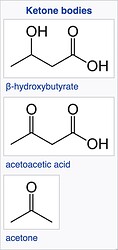This story's going to blow your socks off:
It is ENORMOUS ENORMOUS ENORMOUS.
Consider this: are you familiar with the process of ketosis and ketogenic dieting? The word ketone is derived from Aketon, an old German word for 'acetone'. (Wikiless link)
Now more carefully consider acetone vs acetate specifically:
https://wikiless.tiekoetter.com/wiki/Acetone?lang=en
Now let's step back to a ketogenic diet:
"In 1921, Rollin Turner Woodyatt reviewed the research on diet and diabetes. He reported that three water-soluble compounds, β-hydroxybutyrate, acetoacetate, and acetone (known collectively as ketone bodies), were produced by the liver in otherwise healthy people when they were starved or if they consumed a very low-carbohydrate, high-fat diet. ...
Now back to the original article:
"The results were stunning. The plants were able to grow in the dark using the acetone-making electrolyzer. The algae grown using the method was roughly four times more energy efficient than the solar photosynthesis method."
Nature journal article:
https://www.nature.com/articles/s43016-022-00530-x
Acetate can be metabolized by crop plants
To further evaluate whether carbon fixed through CO2 electrolysis could be used to produce plant-based food, we examined the potential of acetate to serve as a carbon and energy source for crops. We tracked acetate incorporation into plant biomass using heavy-isotope 13C-acetate labelled at both carbon atoms to evaluate whether exogenous acetate can be metabolized by crops. Previous acetate incorporation studies have primarily focused on metabolites involved in lipid biosynthesis in only a few plant species. In these studies, acetate was used in low concentrations as a tracer, not as a carbon source (Supplementary Table 4)34,35,36. To investigate acetate utilization as a carbon source, we grew undifferentiated lettuce tissue (callus) (to avoid the carbon and energy stored in seeds) in the dark in liquid media containing effluent (0.691 M acetate: 1 M KOH) and added in 13C-acetate to enable tracking of carbon incorporation. Calli showed extensive 13C-labelling in multiple pathways, confirming that lettuce tissue metabolizes acetate as a carbon and energy source (Fig. 4a). Labelling of citrate/isocitrate, succinate, α-ketoglutarate and malate indicated that exogenous acetate was converted to biologically active acetyl-CoA and entered the tricarboxylic acid cycle (TCA) cycle to produce energy (GTP, NADH and FADH2) (Fig. 4a). Amino acids were also labelled with 13C, indicating that carbon from acetate can be used to build proteins. Products and intermediates of gluconeogenesis were also labelled, indicating that carbon from acetate can be used for carbohydrate biosynthesis (Fig. 4a and Extended Data Fig. 4). Carbon incorporation of 13C-acetate into amino acids and sugars through the TCA cycle, glycolysis and gluconeogenesis provides strong evidence that exogenous acetate can be readily incorporated into the bulk biomass of lettuce tissue grown in dark conditions and could be a carbon and energy source for other crops."
To be clear:
Wow @Soretna , the acetone based alternative to the sunlight driven photosynthesis in plants entirely validates the Etidorpha's amazing description of plants growing in the Cavern worlds below...not just that this research opens up the following possibilities :
-
To feed the growing human population , farming to be initiated even in underground caverns
-
Farming could be done in the far North or far South , even in the darkness of the Arctic or Antarctic winter night
-
Agriculture could be initiated on other planets , even those that receive very little Sunlight , or Starlight in case of exoplanets
Regards
Indeed. This is a further pronouncement that the hollow planets model is feasible everywhere and that life has other mechanisms for THRIVING. Certainly goes to show just how there's a very real chance that all of these previously thought to be barren planets in our solar system and throughout the universe are in actuality TEAMING with life - just not seen. Our planet happens to be unique insomuch that it has life on the outer, normally barren, shell as well!
Yes @Soretna , this just goes to show how VAST Earth's biosphere could truly be in the 3rd dimension (depth) , below the outer surface where we live :)) We have literally scratched only the surface of our hollow planet in terms of it's biosphere , just the tip of the iceberg !
Besides searching for extraterrestrial life forms , there is also a need to search for intraterrestrial life .
Regards
Etidorpha's amazing description, right here!
http://www.holloworbs.com/Etidorchapter_xvii.htm
Cheers!


